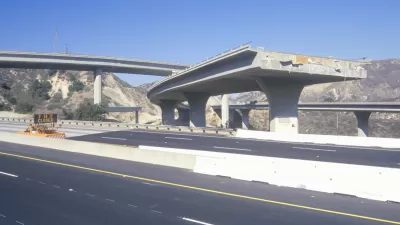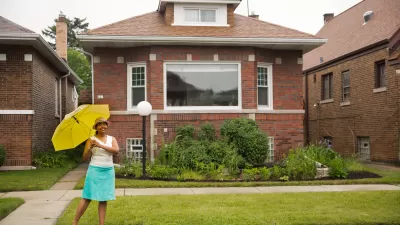I can't remember the last time I left the house and gave a moment's though to whether I'd be warm enough, or whether I needed to bring an umbrella. Meanwhile, half the East Coast is underwater right now.
I can't remember the last time I left the house and gave a moment's though to whether I'd be warm enough, or whether I needed to bring an umbrella. Meanwhile, half the East Coast is underwater right now. Friends on Facebook have posted status updates about "hurricane envy," and the tales of destruction, disruption, heroism, and all-night parties gush in like tidal surges.
Superstorm Sandy will give urban planners pause for many reasons, not the least of which is how to build in low-lying areas in the age of climate change. But seawalls and shoreline setbacks don't interest me nearly as much as the little things:
- Extension cords and power strips with signs inviting passers-by to charge their phones.
- Fireside gatherings.
- Huddled walks through dark, quiet streets.
- Searches for the old and infirm, and efforts to shuttle them to higher ground, in what has become America's corner of the post-apocalypse.
- The elation of making it out alive, and of beholding so much of the city that still stands.
Two days ago a friend of mine walked three miles, over the Brooklyn Bridge, from one borough to another to seek safe haven. How many multitudes must he have passed? How much like Whitman must he have felt?
Planners define cities by their form: the curve of their streets and the massing of their buildings. But we all know that the character of a city -- its values, culture, and, yes, personality -- however ineffable it may seem, matters as much as does the built environment. Usually the two are complementary, of course. Certain places breed certain people.
But places do not breed people so much as they do events.
Most people move to places because of things they like about it. Most planners want to plan places that they think people will like. No one moves to a place with a worst-case scenario in mind. But sometimes the worst-case scenarios are what define cities -- and, paradoxically, perversely, sometimes for the better.
You don't have to be a psychologist to know that hate is a stronger emotion than love, and that fear is stronger than elation. You don't have to have fought in a war to know that trauma can bind people. As New York has demonstrated this week -- as it has so many other times -- the true character of a city lies in shared hardship.
I wish we shared more things, these days. I wish we shared more cups of sugar and bottles of wine. I wish we shared more jokes and stories. I wish we still had mix tapes. But America is usually too busy for those things. Even the greatest American cities are too frantic, to be sure.
I conceive of shared hardship from a position of envy, a position which I know I ought not have. And yet, Los Angeles, my hometown, exists to avoid hardship. We gripe when the temperature drops below 60. All of the real hardships--inconveniences, really--are our own making, and they are not not the kind that ennobles civic character.
Nothing pains Angelenos as much as traffic does. But we are not in traffic. We are not fighting, together, against a common current. We are traffic. We are all each other's enemies. There is no beast to slay. And traffic, much as we might like to commiserate, drives us apart from each other by definition. We are at our most miserable and our most alone at the very same time.
As for the obvious: earthquakes are a special kind of disaster. Nothing in this world strikes with so little announcement. The earthquake proclaims itself, without time for us the jolted to summon our inner tenderness. The worst of them entail endless seconds of terror followed by an indefinite period of being pissed off, jumpy, and anxious. Holding each other closely does no good; it just heightens the chance that you'll be crushed by the same chunk of ceiling. Our signature weather event is the Santa Ana winds, which yield nothing but sleeplessness, irritability, and dry skin.
Los Angeles wears its indifference like a Prada label. I'm a pretty friendly guy, and I don't know a single neighbor's name. In Los Angeles, we complain a lot. But we do not suffer.
Consider so many other places and how they cope. In the Twin Cities, you can't help but be "Minnesota nice" when you know that six months of frigidity and five-foot snowdrifts are in the offing. The Cajun spirit was forged in New Orleans in part by decades of hurricanes, of which Katrina is only the latest example. The chill of Denver pushes 20-somethings into bars and brewpubs; same for the rain in Seattle and Portland. Civic pride in San Francisco and Chicago both arise in part from those cities' ashes. Across the Great Plains, tornadoes, hail, and even a good thunderstorm will do.
And there's always New York: blackouts, blizzards, hurricanes, and other acts to which no God would ever lay claim.
In each of these cases, disaster and discomfort have raised civic spirits. They inspire little gestures, like shoveling a neighbor's sidewalk or letting her borrow your cell phone. They create heroes. They wash away dreams and force residents to rebuild. People to congregate on streetcorners, forget about their phones and computers, and share some stories. If the corner bar or cafe stays open, that's where the neighborhood rides out the storm. Sometimes, when the lights go out, they lead to even more residents.
One Facebook friend wrote, with the raw eloquence that can only come from intense experience: "People laying prostrate next to outlets at banks and restaurants; putting makeup on in public restrooms; cheering when linksys is a wifi option; trucking a suitcase around with you everywhere; drinking at all times of the day; endless delays and thus more drinking New York City literally has become one giant airport."
Meanwhile, people out here--no matter how strong our feelings of sympathy and support may be--are selling scripts and doing Pilates.
Not I nor anybody else would wish Superstorm Sandy on anyone. And yet, there's that envy. The envy derives from our fascination with the power of nature, to be sure. But it is, I think, also an envy of human contact. It's an envy of how we feel, about ourselves and about each other, when we collectively face something more awesome than we are. It's an envy that comes from the conviction that something good must come of this.
As the post-Sandy days wear on, I dearly hope that spiritedness does not give way to frustration, with so much to rebuild and so much drying-out left. I don't know what the threshold is for despair or when frayed nerves will overwhelm the cooperative instinct.
In New York next week, I hope we don't find out. In Los Angeles, as in so many other places forged in the name of comfort, I know we will never find out. In a perfect world, one that looks superficially like Los Angeles and not at all like Atlantic City, everyone would always work to make life better. The brawn needed to sump basements and haul debris would go towards noble buildings and flat sidewalks. The momentary cooperation would be spread into daily nods and smiles.
As the people of the East Coast undergo these trials involuntarily, may the rest of us, who have the luxury of light, power, and mobility, show our mettle in ways of our own choosing so that no one and no place needs to be the object of envy.

Depopulation Patterns Get Weird
A recent ranking of “declining” cities heavily features some of the most expensive cities in the country — including New York City and a half-dozen in the San Francisco Bay Area.

California Exodus: Population Drops Below 39 Million
Never mind the 40 million that demographers predicted the Golden State would reach by 2018. The state's population dipped below 39 million to 38.965 million last July, according to Census data released in March, the lowest since 2015.

Chicago to Turn High-Rise Offices into Housing
Four commercial buildings in the Chicago Loop have been approved for redevelopment into housing in a bid to revitalize the city’s downtown post-pandemic.

Median Home Prices Top $1 Million in Over 200 California Towns
Towns once known for their affordability are seeing sharply rising home prices.

LA County Receives Reconnecting Communities Grants
Seven grant awards totaling $162 million will be used for planning, capital projects, and regional partnerships to reduce environmental harm and improve access in disadvantaged communities.

Seine Pollution Could Hinder Olympic Swim Events
Events like the triathlon could be impacted if tests continue to reveal high levels of dangerous bacteria in Paris’ famous river.
Licking County
Barrett Planning Group LLC
City of Cleburne
HUD's Office of Policy Development and Research
Mpact Transit + Community
HUD's Office of Policy Development and Research
City of Universal City TX
ULI Northwest Arkansas
City of Laramie, Wyoming
Write for Planetizen
Urban Design for Planners 1: Software Tools
This six-course series explores essential urban design concepts using open source software and equips planners with the tools they need to participate fully in the urban design process.
Planning for Universal Design
Learn the tools for implementing Universal Design in planning regulations.






















